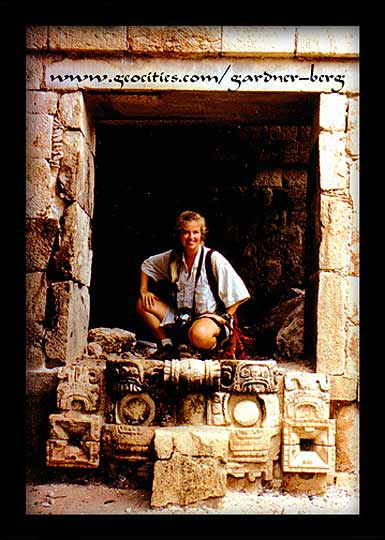
Codz Poop, Kabah, MEXICO
Translate:
Espa˝ol - Franšais
- Deutsch
- Italiano
- Portuguŕs
- Japanese
- Korean
- Chinese

Codz Poop, Kabah, MEXICO
Translate:
Espa˝ol - Franšais
- Deutsch
- Italiano
- Portuguŕs
- Japanese
- Korean
- Chinese

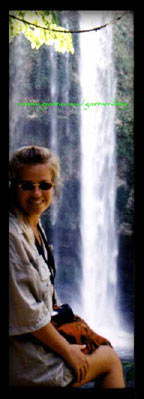 May 30, 1999 -- We take a day trip to the waterfalls of Misol Ha and to swim at the water cascades of Agua Azul. A wonderful way to escape the intense heat and humidity.
May 30, 1999 -- We take a day trip to the waterfalls of Misol Ha and to swim at the water cascades of Agua Azul. A wonderful way to escape the intense heat and humidity.
May 31, 1999 -- We leave Palenque for 2 days and ride in a Combi Van heading SE alongside the Guatemalan border/Usumacinta River to Lacanja where food and camping facilities are available. There is a community of Lacandon Indians (only about 500 survive today) easily recognisable by their long curly hair and wearing white gowns. We were in good company as well, with other travellers from Italy, Switzerland, Argentina, and USA.
That afternoon we walk from the village to Bonampak (2 and a half hours - 9kms). Our guide was a local Indian lady - very short but none of us could match her walking speed.
Bonampak (dated between 790 and 792 AD) has murals illustrating scenes from royal life. They also show the more aggresive side of Mayan civilisation - scenes of torture and decapitation for prisoners of war.(Discovered in 1946)
We head back to camp with enough time to take a dip at a nearby 'cascada' before dinner. During dinner, the old man that runs the camp, speaking only in Spanish, explains some of the history involving his people. We didn't really understand much, but you could tell by the quiet low tone in his voice that the story was sad. We felt that, with the very low numbers surviving today, he senses the end of his culture is drawing near.
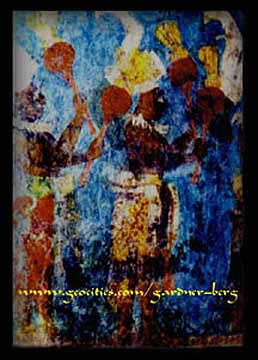
June 1, 1999 -- After breakfast, we pile into the Combi along with other travellers just arriving from Palenque and head to Echeverria to catch a river boat going to the ruin site of Yaxchilan (about an hour NW on the Rio Usumacinta). As the boat speeds towards its destination, we pass a few small villages on the river bank with many children taking advantage of the cool waters on this very hot and humid day.
Yaxchilan - a major Classic-Period Maya centre built on the river's edge holds evidence of bloodletting rituals conducted by Late Classic rulers and the family members. This form of self-sacrifice was believed to ensure the correct function of the world e.g. appeasing their gods for good harvests. The lintels at Yaxchilan show images of the royal family performing bloodletting acts: the King would pierce his penis with a large spike, while the Queen runs a rope covered in thorns through her tongue.
A return to Echeverria for our last meal before heading back to Lacanja to say our goodbyes, then fast-tracking it back to Palenque.
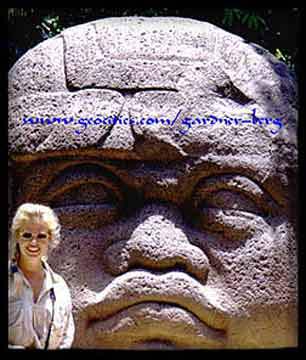
June 2, 1999 -- (1000) We hop on a bus leaving Palenque heading north to Villahermosa, the city of the state of Tabasco.
In 1925, an expedition made a remarkable discovery of huge sculptured human and animal figures, accompanied with urns and altars in almost impenetrable forest at La Venta. La Venta was to become another protected arqueological site. But, in 1950, these monuments were threatened with destruction by the discovery of oil. A poet by the name of Carlos Pellicer had all the artifacts hauled to a woodland area of Villahermosa and created a beautifully set outdoor museum called the 'Parque Nacional de La Venta'.
It's a wonderful place to visit where the stone figures are displayed along the path that worms its way around the park. There is also a great museum, housing the more fragile artifacts, nearby. The park is also an outdoor zoo - where animals are roaming around freely thus creating a more natural atmosphere. Well worth the visit.
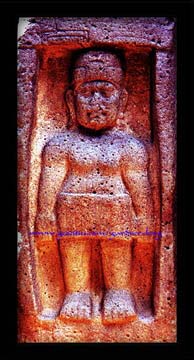
June 3, 1999 -- (0900) A visit to the 'Centro de Investigaciones de las Culturas Olmecas'(CICOM) museum for a couple of hours then we catch a 1230 bus to the town of Colmalcalco (1 and a half hours NW). From the small town, a 3 km walk takes us to the Maya ruins of Comalcalco. The western-most major Mayan city. A well-maintained site and very interesting in that, unlike others we've visited so far, its pyramids and palaces were built using long and narrow bricks instead of stone; a unique feature in Mayan architecture.
June 5, 1999 -- (0910) We leave Villahermosa heading eastward, crossing the path of Rio Usumacinta flowing from the Guatemalan highlands and draining into the Gulf of Mexico. We are now in the Yucatan Peninsula. We then curve northward towards the city of Campeche, capital of the state with the same name on the west coast.
The area covering the Yucatan, Guatemala, Belize and parts of Honduras and El Salvador of today was once the region of the Maya. Colonization began around
1500BC, but it wasn't until around 150AD that the emergence of the first city states became apparent in the central lowlands of today's El Peten in Guatemala. The religious centre of this early empire was Tikal - a city known
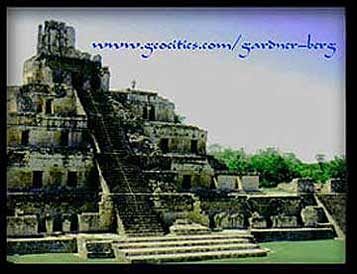 for its extraordinary pyramid architecture. By 900AD, this area was largely abandoned and the focus of development moved north to the Yucatan. Within 300 years, however, many of the cities of the Yucatan were also abandoned, often quickly, raising speculation of conquest, disease or prolonged drought, as possible causes for their decline.
for its extraordinary pyramid architecture. By 900AD, this area was largely abandoned and the focus of development moved north to the Yucatan. Within 300 years, however, many of the cities of the Yucatan were also abandoned, often quickly, raising speculation of conquest, disease or prolonged drought, as possible causes for their decline.
June 6, 1999 -- Originally the Mayan trading village of 'Ah Kim Pech', Campeche was the site where, on March 20, 1517, the Spaniard conquistadors (under the leadership of Francisco Hernandez de Cordoba), first landed on Mexican soil and thus began mestizo Mexico. During the next 100 years after its foundation
(1540) the city prospered, becoming a major trading port for the export of local dyewoods, timber and other valuable cargoes, therefore making Campeche a target for frequent pirate/buccaneer attacks. The city fell on 9 February, 1663 with its inhabitants slaughtered. A few years later the Spanish Crown decided to fortify the site, building a wall thick and high, to completely surround the settlement taking 36 years to complete. This included the construction of 8 fortresses at points spread around the structure. The precautions apparently paid off. Campeche prospered once again; up until Mexican Independence (proclaimed in 1821).
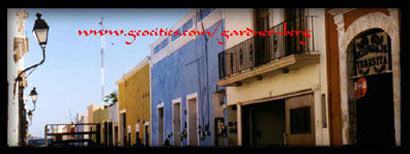
Now, as we walked around Campeche's quiet, narrow streets, we see the remains of the baluartes and fortresses (7 are still standing), still possessing the strength for its original purpose, but somewhat even more daunting when modern buildings stand against them. But this mixture of old and new sometimes makes for fascinating pictures.
June 8, 1999 -- The closest arqueological site from Campeche is Edzna (House of Grimaces)- 61kms away, a difficult place to get to by public transport. We used the expensive tourist transport to get there, but at least, we were the only 2 people going, having the whole site to ourselves.
Edzna was a huge ceremonial centre, occupied from about 600BC to 200BC; a 30m high, 60sq.m. base 'Temple of the Five Storeys is the highlight of the site - a stepped pyramid with 4 levels of living quarters reserved for priests. At the top is a shrine and altar. We also saw our first 'sacbe' here - white road/causeway - (we will see more of these later). Those roads were used as trading routes between some centres around the area.
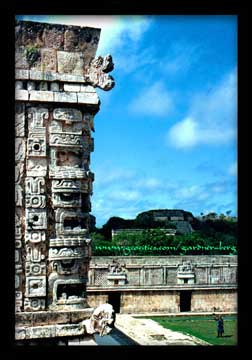
(1230) We arrive back to Campeche and continue with a 4km walk along the coastal road to the 'Fuerte de San Miguel' - one of the fortresses which has now been converted into a museum - 'Museo Arqueologico' - containing some recently discovered items from Jaina (N of Campeche on the coast about 40km). Jaina is an island of limestone where, in 1943, an extensive Mayan burial ground was discovered. The artifacts found buried with the bodies such as the terracotta figurines, food, weapons, tools and jewelery revealed much about the Maya customs, dress and living habits of the Late Classic Period (600 to 900AD).
June 9, 1999 -- (1:00pm) A bus to our next destination: Merida, capital of the neighbouring Yucatan State (252km and 2 and a half hours by bus).
Merida, founded in 1542 by Francisco de Montejo the Younger, was built on the site of the old Maya city of Tiho (or Ichcansiho). In the mid-nineteenth century, Mayan peasants rose in revolt against the 'criollo' families of Merida
(Spanish colonists) - 'The War of the Castes' was particularly a sad period in Mexican History. A great number of Mayan families - whose lands were stolen from them with their personal liberties curtailed; and many were sold into forced labour on tabacco and henequen plantations - had lost their lives under the ruthless authority of General Porfirio Diaz (Mexico's ruler: 1876 - 1910).
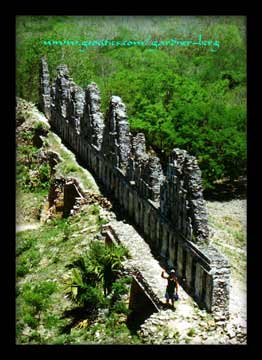
Interestingly, when the Mayan peasants began their revolt, the besieged elite of Merida offered to become a colony of the United States or Britain in exchange for protection rather than relying on the slow response of Mexico City.
Today, Merida is a modern 'bustle' - heavy traffic in narrow streets, steet-sellers of every type constantly approaching us - some are polite, others are verbally abusive. There seems to be general hostility towards foreigners here, particularly around the Municipal Market but a 'no response' approach seems to be quite effective sometimes.
June 10, 1999 -- Just a couple of blocks away from our hotel is the Parque San Juan where we catch a Combi van heading N for half and hour to Dzibilchaltun. This ruin site consists of 2 halves connected by a sacbe (white road) - founded around 1000BC. The western half is the ceremonial centre with temples, houses and a large plaza. Seemingly out of place is a ruined colonial church. There is also a 44m deep cenote close by.
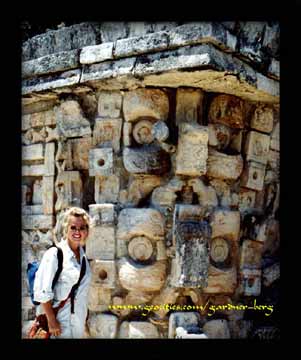 Of interest to us was the eastern end of the site. The 'Templo de las Siete Mu˝ecas' (Temple of the 7 dolls) - named because of figurines with deformed features found within. This temple features windows, a vaulted corridor, and an inner chamber carefully built so as to show key solar alignments. During these times, the temple lights up like a beacon when standing on the western section.
Of interest to us was the eastern end of the site. The 'Templo de las Siete Mu˝ecas' (Temple of the 7 dolls) - named because of figurines with deformed features found within. This temple features windows, a vaulted corridor, and an inner chamber carefully built so as to show key solar alignments. During these times, the temple lights up like a beacon when standing on the western section.
June 11, 1999 -- We embark on what is known as the 'La Ruta Puuc' bus route - a more 'touristy' route which leaves Merida 0800 and heads to 5 ruin sites with 30 mins waiting time for each site except for Uxmal (2 hours) and returning back by 5pm. Not really our favourite way of visiting ruins - the bus being filled with many foreign travellers, some quite aggressive and verbally condescending, especially with the constant bantering for supremacy between those who are supposedly more knowledgable and experienced. It's best not to take part in these games. The bus service should have been renamed 'The Ego Trip'. This is one of the ugly sides of independent travel.
We have entered the region of Mexico called the 'Gringo Trail' which covers the majority of the Yucatan Peninsula. A generally safe but over-priced tourist area of Mexico where services cater mainly to the richer travellers touring from the Cancun region. But it does make the going easy for us for a short while.
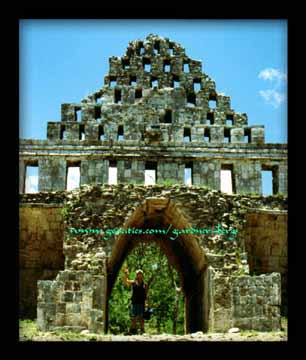 Our first site 88km away is Labna - a Late Classic period site (600 to 900AD) with finely-cut masonry and intricate facades in carved stone. There is a complex of 4 buildings arranged around a courtyard called a 'quadrangle'. This site has 2 of these lying side by side and connected by a magnificent vaulted doorway, known today as the 'Arch'. There is a room on either side of this doorway. Above the doors to these rooms are hutshaped niches which once held stucco statues.
Our first site 88km away is Labna - a Late Classic period site (600 to 900AD) with finely-cut masonry and intricate facades in carved stone. There is a complex of 4 buildings arranged around a courtyard called a 'quadrangle'. This site has 2 of these lying side by side and connected by a magnificent vaulted doorway, known today as the 'Arch'. There is a room on either side of this doorway. Above the doors to these rooms are hutshaped niches which once held stucco statues.
The next ruin site is Sayil - known for its 'Gran Palacio' and its ornamented facade.
Xlapak has one well-constructed palace and 2 partially reconstructed buildings.
Kabah has the impressive 'Codz-Poop'(a funny name meaning 'Palace of Masks'), which its facade bears the image of the rain gad 'Chac' repeated 260 times - the number of days in the Mayan Almanac Year. The Maya calendar used various separate cycles - the most important of which were:
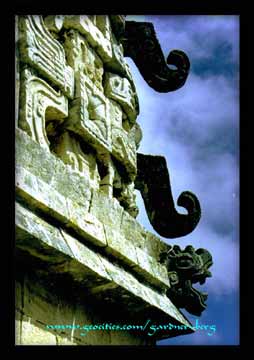
The 'Tzolkin' or 'Almanac' calender - days were symbolized by both a number (1 to 13) and one of twenty names. The cycle lasted 260 days (i.e. 13x20) and then repeats itself.
The 'Haab' or 'Vague' year - named as such because it was a quarter of a day short of the solar year. This cycle is made up of 18 months where there are 20 days in each month and at the end of the year a 'short month' of 5 dark or unlucky days altogether making up a total of 365 days.
The Great Cycle of 5200 'tuns' or '360 day-years'. As opposed to the Christian calendar, the Mayan version has a zero year known as '4 Ahau', a point in time corresponding to 13 August, 3114BC on our calendar. All dates of major events in Maya history were recorded on stone, paper, terracotta and bone, using '4 Ahau' as a reference point.
Our final stop is Uxmal - home of the Xiu tribe - covering a relatively small area but the architecture is on a grand scale where the main structures are extensively decorated with stylised symbols related to the cycles of the planet Venus, of serpents and the rain god - Chac. Uxmal is the largest city in this section of the Yucatan called the 'Puuc' region.
Photos and Text Copyright ę 1999-2001 Gardner-Berg. All rights reserved.
Sources of Further Reading-
Baudez, Claude and Picasso, Sydney. "The Lost Cities of the Maya" Henry N Adams, Inc., New York, NY. 1992.
Bernal, Ignacio, "A History of Mexican Archaeology: The Vanished Civilizations of Middle America" Thames and Hudson, New York, NY.
Coe, Michael, D. "Lords of the Underworld: Masterpieces of Classic Mayan Ceramics", Priceton University Press, NJ.
Drucker, Phillip. "La Venta, Tabasco: A study of Olmec Ceramics and Art." 1952
Kelly, Joyce. "An Archaelogical Guide to Mexico's Yucatan Peninsula (Yucatan, Quitana Roo,and Campeche)" University of Oklahoma Press, Norman and London. 1993.
Miller, Mary E. "The Art of Mesoamerica, From Olmec to Aztec" Thames and Hudson, New York, NY.
Perry, Richard. "Exploring the Colonial Chiapas" Espandana Press.
Schele, Linda and Freidel, David A. "A Forest of Kings: The Untold Story of the Maya" Morrow New York, NY.
Stephens, John L and Catherwood, Frederick. "Incidents of Travel in Central America, Chiapas and the Yucatan"
Stuart, George C and Stuart, Gene S. "The Mysterious Maya" National Geographic Society, Washington DC., 1997.
Wright, Ronald. "Time Among the Maya"

